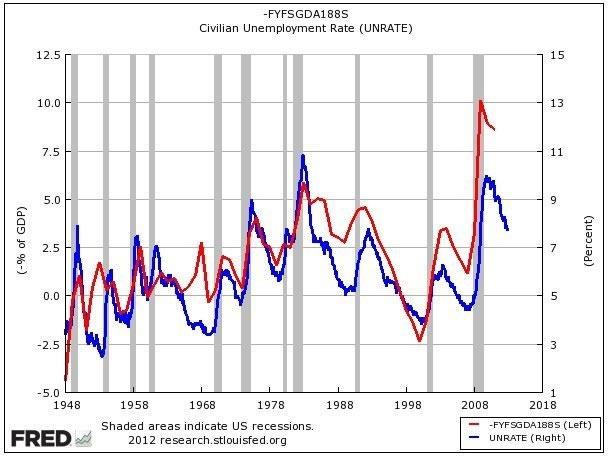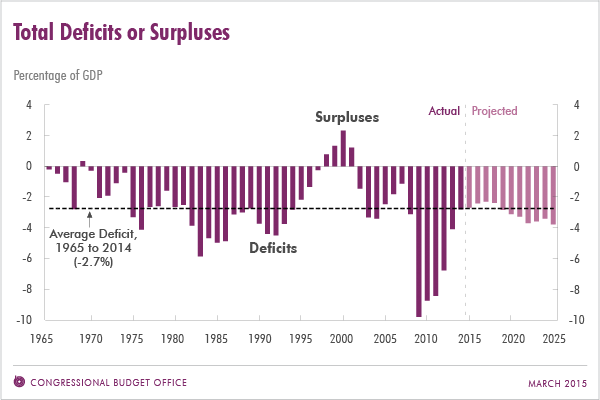|
 NATIONAL
JOBS FOR ALL COALITION NATIONAL
JOBS FOR ALL COALITION
UNCOMMON SENSE 1
© June 2015
[Rev.]
INCREASING
UNEMPLOYMENT INCREASES
THE DEFICIT
REDUCING
UNEMPLOYMENT REDUCES THE DEFICIT
By
Helen Ginsburg, Professor of Economics, Brooklyn College
of the City of New York and Executive Committee, National Jobs
for All Coalition, and Bill Ayres,
Director, World Hunger Year and Advisory Board, National Jobs
for All Coalition.

This issue was written at a time when the major source
of deficits was recession. These days, it is military
spending, tax cuts, and bank giveaways, which generate relatively
few jobs, along with health care, as well as recession, so that
our deficits are not merely cyclical1 but structural.2
This means that we'd have a deficit even at high employment. The Congressional Budget Office [CBO]'s
estimates of the "high" employment [5.5% unemployment3]
deficit or surplus4 once usually showed at most a small
deficit. In contrast, there has been a large high-employment deficit
since Bush II and beyond. The
CBO projects a fiscal 2012 cyclically-adjusted deficit of $703
billion. Needless to say, it is still true that deficits are
smaller with higher employment [see graph below]. The CBO appears to have given up this calculation.
Unemployment & Federal Deficit as% GDP

Source: Weisenthal, "There's Only one Way to Fix the Deficit-- and Actually It's Totally Painless"
This CPEG Powerpoint presentation explains why significantly reducing the current federal deficit will cause higher unemployment, unless accompanied by trade deficit reduction or another deficit bubble. [JZ, Editor]
The President and
Congress try to outdo one another on who can cut the Federal budget
deficit the most. But efforts to reduce the deficit at the expense
of necessary social programs are unnecessary and counter productive.
In fact, much of the recent reduction in the deficit is due to
the decline in unemployment.
According to the last
Congressional Budget Office estimate of the impact of unemployment
on the deficit,5 a
reduction of unemployment by only one percentage point
starting in January 1995 and sustained through fiscal year 2000
would have netted the government $415 billion over those six years.
Most of that would come from increased taxes paid by more people
working and greater business profits ($315 billion). The rest
would result from less money needed for unemployment insurance
and other social programs ($32 billion), and less money spent
on interest payments to service the debt ($68 billion--$23
billion in fiscal year 2000 alone).
Remember, this $415
billion is from only a one percentage point decrease in unemployment.
The mind boggles when confronted by how much could be generated
if we actually reached a level of full employment. Think of how
that money could then be reinvested in our society to fund the
education and training programs we need to raise more than a quarter
of our citizens out of poverty and near-poverty, to eliminate
hunger, rebuild our transportation systems, housing, and recreation
areas, improve our environment and support working parents with
child care.
Every percentage point
less in unemployment makes good economic sense by not only reducing
the budget deficit, but also reducing the human deficit that we
see in the economic insecurity, growing poverty, hunger, homelessness
and crime that are tearing apart our society. We'll get stronger
families and an enhanced quality of life.
Let's have full employment
and reinvest the savings into a more productive, livable society
with Jobs for All!
[1] resulting from recession.
[2] they'll still be there when the recession is over.
[3] http://www.cbo.gov/publication/43903
Obviously, this target is far above which NJFAC and other supporters
of full employment consider an acceptable level of unemployment.
[4] what the budget balance would be if we were at 5.5% unemployment,
"high" employment, presumably the best the CBO considers
that our economy can manage.
[5] Congressional Budget
Office, Economic and Budget Outlook: Fiscal Years 1996-2000
(Jan 1995). The CBO for years has made this estimate, but
no longer does so. For further information about the deficit,
see Sheila D. Collins, Helen Lachs Ginsburg and Gertrude Schaffner
Goldberg, Jobs For All: A Plan for the Revitalization of America,
New York: Apex Press. 1994. Chapter 10.
"...we are still in a downturn, with the economy operating at a level of output that is more than $1 trillion below its potential according to the Congressional Budget Office. ....The most recent projections from the Congressional Budget Office show a baseline deficit projection for fiscal 2014 of around $600 billion. If the economy were operating at potential GDP, this would reduce this figure by around $300 billion. (An additional dollar of output will lead to roughly 30 cents in savings to the government due to higher tax collections and lower payments for programs like unemployment benefits and other transfers.)
This leaves a deficit of around $300 billion or roughly 1.8 percent of GDP. With a deficit of this size the debt-to-GDP ratio would be falling, which means that the government can run a deficit of this size in perpetuity. It is true that in the longer term the deficit is projected to rise due to the rising cost of health care. The United States pays more than twice as much per person for its health care as other countries with nothing to show for this spending in terms of outcomes." http://www.cepr.net/index.php/blogs/beat-the-press/its-monday-morning-and-robert-samuelson-is-confused-about-the-economy
 Source: https://www.cbo.gov/publication/49973 Note correspondence of higher unemployment with larger deficitsduring recessions of early 1980's, early 2000's and financial crisis[late 2007] and surpluses of late 1990's relatively low unemployment. Source: https://www.cbo.gov/publication/49973 Note correspondence of higher unemployment with larger deficitsduring recessions of early 1980's, early 2000's and financial crisis[late 2007] and surpluses of late 1990's relatively low unemployment.
Editor:
June Zaccone, Economics (Emer.), Hofstra University
|

